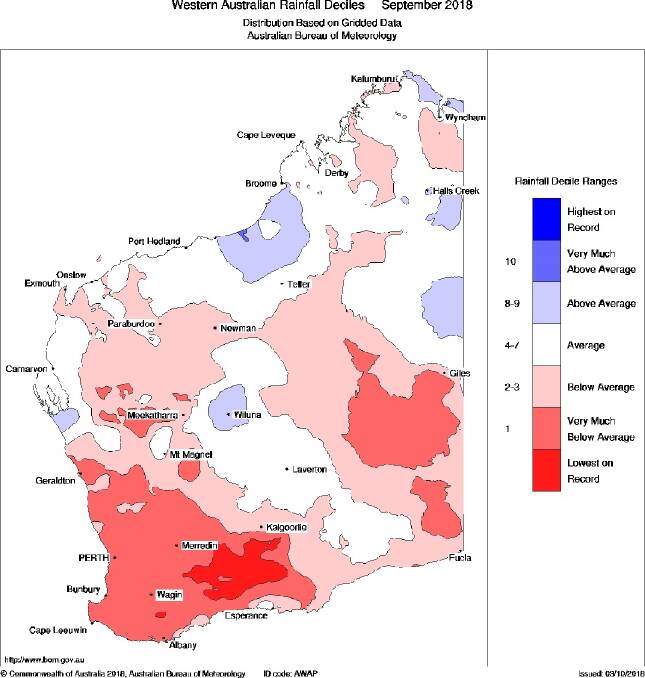
THOUGHT your September was crook? There are now statistics to back it up, with the Bureau of Meteorology (BoM) declaring this September to be the driest on record, increasing longstanding rainfall deficiencies in drought impacted eastern Australia and hurtling southern Australia towards a similar predicament. The BoM data showed the month was especially dry across the southern mainland. Many parts of Victoria recorded their lowest September rainfall on record, with a number of north-western centres not recording 5mm for the month, compared to a long-term average of 20-50mm. It all added up to the month being the driest September on record nationally, and the second driest September on record for Victoria, third driest for Western Australia, and fourth driest for South Australia. The extent of the southern dry is reflected in rainfall totals in the lowest 10 per cent of historical rainfall totals for the month in large areas including greater south western WA (south west of a line between about Geraldton and Esperance), South Australia from Ceduna east across the Eyre Peninsula and agricultural districts, much of the western half of New South Wales, and nearly all of Victoria except parts of South and West Gippsland. BoM reported rainfall in September was below to very much below average in the south west, north east, and south east parts of the State. It was the third-driest September and driest in eight decades since 1939 for the State as a whole. For the South West Land Division, it was the fourth-driest start to spring and driest since 1939. Rainfall totals were mostly less than 10 mm in the Gascoyne, Goldfields and Eucla districts, and the north and east of the south west apart from its coastal areas. Hyden recorded its driest September in 89 years of 3mm, the previous record from 1954 with 4.6mm, with the site averaging usually 27.8mm for the month. Gingin and Nunile also recorded their driest Septembers on record, although BoM’s record for those sites only dates back 30 years. Another 39 sites recorded their lowest September rainfall in the past 20 years with Pingelly, Doodlakine, Northam, Ravensthorpe, Mukinbudin, Dandaragan and Bullfinch on the list. Salmon Gums recorded 3mm for the month, with Goodlands only recording 4.4mm and Bonnie Rock with 2.8mm. The mean maximum temperatures were above average across most of the State whilst the mean minimum temperatures were generally near average except in the south west where the overnight temperatures were below average. Recorded daytime temperatures were above average for most of the State with the mean maximum temperature 1.6 degrees above average for WA as a whole. Clear skies and light winds led to two consecutive very cold mornings in the lower half of the State on September 15 and 16, with a number of sites breaking their lowest September temperature record. It was a marginally better result in other parts of the country but not enough to make up the deep rainfall deficit. Compared to other January to September periods since 1900, year-to-date rainfall has been the second lowest on record for the Murray-Darling Basin, third lowest for New South Wales, and eighth lowest for Victoria. The area of severe rainfall deficiency now extends further into eastern and northern Victoria, eastern South Australia, inland southern Queensland, and south coast WA than compared to periods ending August 2018. Accompanying recent low rainfall have been unusually high day-time temperatures, which add to the impact of reduced rainfall, as seen through reduced soil moisture. Australian maximum temperatures for 2018 to date have been the second warmest on record with an anomaly of +1.36 °C (behind 2013 with an anomaly of +1.54 °C). Both New South Wales (+2.17 °C) and the Murray-Darling Basin (+2.10 °C) have experienced their warmest January-September period on record. There has been relief for some, however, in early October. Along with the news the threat of El Niño is lessening, a big cold front has delivered good rain across NSW in particular. South west NSW, one of the hardest hit areas by drought, received widespread falls of 25-50mm. Menindee received 50mm in the deluge earlier this week. To put it into perspective, the far western town had only received 36mm for the entire year up until the downpour.

